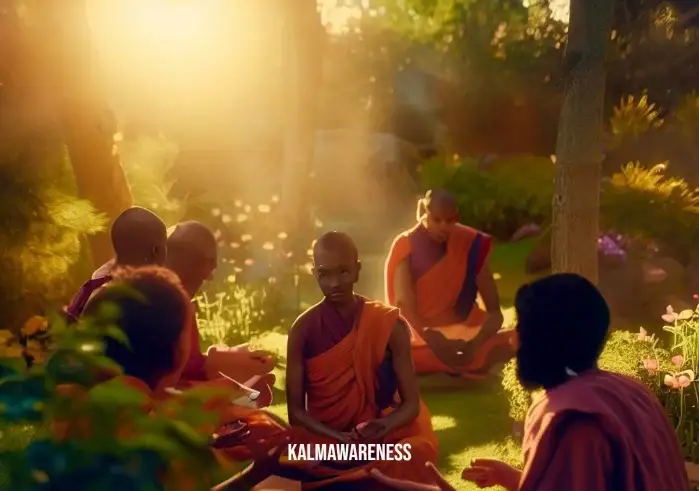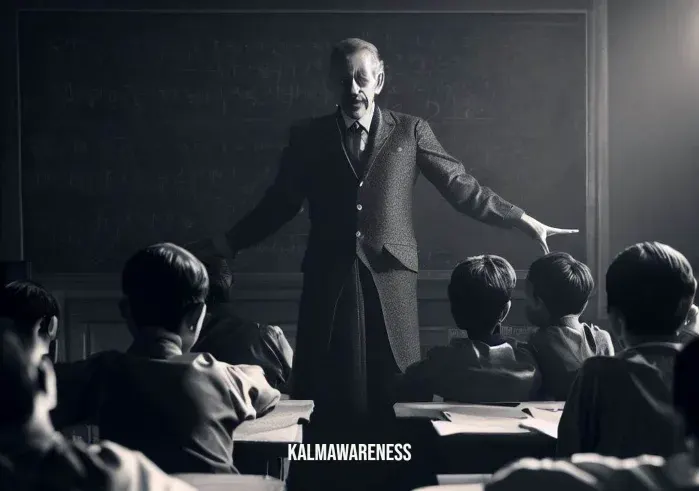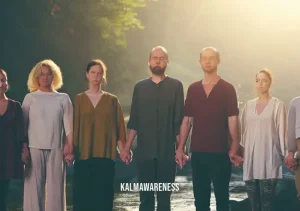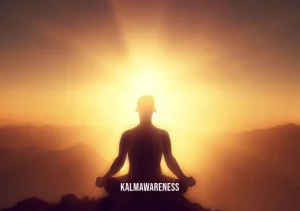Abhinivesha: Understanding the Fear of the Unknown and the Path to Liberation
In the expansive world of yoga and philosophy, there is a concept that profoundly impacts our attachment, fear, ego, and ultimately, our path to liberation. This concept, known as abhinivesha, throws light on our innate fear of death or the unknown and our deep-rooted attachment to life. Let’s dive deep into this intriguing concept and explore how it affects our lives and shapes our consciousness.
Abhinivesha, derived from the ancient language of Sanskrit, can be translated as the fear or apprehension of death, symbolizing our strong desire to live or the clinging to life. It’s one of the five ‘kleshas’ or afflictions mentioned in the Yoga Sutras of Patanjali, which hinders our path to spiritual growth and enlightenment.
This article embarks on an exploration of abhinivesha, the attachment to life, and its profound effect on our fear, ego, and liberation. Let’s begin by understanding how it is deeply rooted in our subconscious and subtly affects our thoughts, emotions, and actions.
The Root of Fear: Unraveling Abhinivesha
Abhinivesha is not merely about the fear of death but extends beyond that. It refers to the fear of the unknown, the anxiety of uncertainty, and the resistance to change. It is intricately linked with our mind over heart meaning, where we let our minds rule our emotions and actions, often leading us to irrational fears and anxieties.
The Yoga Sutras of Patanjali suggest that abhinivesha is so deeply rooted that it persists even in wise and learned individuals. It is this deep-seated fear that often triggers reactions like attachment, anger, or aversion, which further strengthen our ego and hamper our journey towards liberation. Our article on how I see the world offers insights into how our perceptions can shape our fear and anxieties.
Understanding abhinivesha is akin to understanding the moments in time meaning as it is an unconscious drive that impacts how we experience life. It is about acknowledging our fears and attachments and taking the first step towards liberation and self-realization.
Attachment and Ego: Entwined with Abhinivesha
Our fear of death or change, or the unknown, is deeply tied to our attachments and ego. To live life fully and to move toward liberation, we must first identify these fears and attachments.
Our mind you definition provides a comprehensive understanding of the mind and its entanglement with ego and fear. The ego, in essence, is our sense of self, our identity. It is our conception of who we are and how we fit into the world. When this ego is threatened, it results in fear and further strengthens our attachments. Delving into the ego meditation can provide a profound understanding of ego’s role in shaping our fears and attachments.
In the grand scheme of things, abhinivesha triggers a self-preservation instinct in us. This instinct is neither good nor bad in itself, but it often leads to an inflated ego and over-attachment, resulting in fear and suffering.
Abhinivesha, attachment, fear, and ego are interconnected and have a significant influence on our consciousness and spiritual growth. To navigate through this intricate maze and move toward liberation, it is crucial to understand and acknowledge these elements in our lives.
As we delve deeper into this topic, we invite you to join us in the next part of this article. Here we will discuss how abhinivesha affects our path to liberation, and we will explore some strategies for overcoming this deep-seated fear and attachment. Let’s continue our journey towards self-discovery, understanding, and liberation in the realm of abhinivesha.

Liberating the Self: Overcoming Abhinivesha
As we delve deeper into our exploration of abhinivesha, our understanding of this instinctive clinging to life and resistance towards death or change becomes increasingly crucial. This chapter will focus on the strategies to overcome this deeply-rooted fear, our path to liberation, and how we can strive to live a life free of the clutches of abhinivesha.
From Fear to Liberation: The Role of Abhinivesha
It is often said that every moment of fear is a step away from an opportunity for growth. This profound statement is particularly relevant when examining the effects of abhinivesha on our path to liberation. The fear and resistance we experience, as highlighted in life isn’t about how many breaths you take, is an indication of our unconscious clinging to life and our inherent dread of the unknown.
To fully appreciate the liberating power of overcoming abhinivesha, it’s important to understand its impact on various levels of existence, as defined in 7 levels of existence. Our fears, whether related to the unknown or change, reside within us at these different levels and can profoundly impact our path to liberation.
Here are some practical steps to navigate through and eventually liberate ourselves from the stronghold of abhinivesha:
- Acceptance: Accepting that change is the only constant and death is a part of life helps reduce our fear of the unknown. The Buddhist views on love, as outlined in this article, provide insights on embracing impermanence, which can help us better understand and accept change and death.
- Mindfulness: Practicing mindfulness brings us into the present moment, reducing our fear of the future. Our comprehensive guide on mindfulness to meaning theory can provide useful insights on how to cultivate mindfulness.
- Courage: Developing courage to face our fears can play a significant role in overcoming abhinivesha. This courage can be cultivated through various techniques, as discussed in courage meditation.
- Letting go of Ego: Our ego often fuels our fear of the unknown. Learning to let go of ego, as explained in don’t let it go to your head, can be a significant step towards overcoming abhinivesha.
To illustrate the process of liberation from abhinivesha more clearly, the following table provides a summary:
| Strategy | Description | Related Reading |
|---|---|---|
| Acceptance | Embracing impermanence and understanding that change and death are part of life | Buddhist views on love |
| Mindfulness | Being fully present in the moment and reducing fear of the future | Mindfulness to meaning theory |
| Courage | Facing our fears and developing inner strength | Courage Meditation |
| Letting go of Ego | Reducing our ego’s influence to decrease our fear of the unknown | Don’t let it go to your head |
Understanding and overcoming abhinivesha is an essential step on our path to liberation. As we continue this exploration in the next part of the article, we will examine the role of yoga and movement in managing and overcoming abhinivesha. Join us as we delve deeper into this insightful journey of self-discovery, liberation, and transformation.

Harnessing the Potential of the 61 Point Relaxation Technique
In our previous sections, we have explored the concept and benefits of the 61 point relaxation technique and how to incorporate it into our daily lives. Now let’s take our exploration one step further, diving into the more profound effects of this practice and how it can enhance your overall well-being and life quality.
61 Point Relaxation and Emotional Health
There’s an intrinsic link between our physical bodies and our emotional health. With 61 point relaxation, you have a tool to navigate this connection. As you journey through the points, you become more attuned to your body and, consequently, your emotional state.
Our Mindful Living Collective platform provides a variety of resources to further explore the intersection of mindfulness, body awareness, and emotional well-being.
Coping with Stress and Anxiety
61 point relaxation is a potent tool in stress and anxiety management. With regular practice, you learn to navigate stressful situations with greater calm and presence. Reflecting on this, Jon Kabat-Zinn said, “You can’t stop the waves, but you can learn to surf.” Explore this metaphor further in our Mindfulness on the Go resource.
Promoting Body Positivity
As the 61 point relaxation technique fosters a deeper connection with your body, it can serve as a means of cultivating body positivity. You learn to appreciate your body, not for how it looks but for its intricacies, strength, and the fact that it’s your unique home. We delve into this topic more in our articles on befriending your body and how to feel connected to your body.
61 Point Relaxation and Sleep Quality
Insomnia and sleep disturbances are common modern-day challenges. The 61 point relaxation technique can be beneficial in fostering healthy sleep patterns by promoting deep relaxation and a quiet mind, crucial for quality sleep.
A fascinating insight on the topic can be found in our Let Relax guide.
Benefits of 61 Point Relaxation
| Benefit | Explanation | Additional Resources |
|---|---|---|
| Emotional Well-being | Helps in understanding and managing emotions | Mindful Living Collective |
| Stress and Anxiety Management | Promotes calmness and equanimity | Mindfulness on the Go |
| Body Positivity | Fosters a healthier body image | Befriending Your Body |
| Sleep Quality | Assists in improving sleep hygiene | Let Relax |
As we conclude this chapter, let’s reflect on the words of Rumi, the renowned Persian poet, “The wound is the place where the Light enters you.” In the context of the 61 point relaxation, every point you touch could be a place where light and awareness enter, illuminating your path to self-awareness and inner peace.
In the next section of our exploration of the 61 point relaxation technique, we’ll delve into its application for special circumstances, such as during illness, recovery, and significant life changes. We’ll also look at how the 61 point relaxation technique can form part of a holistic self-care routine. So, continue the journey with us!

Embracing Liberation through Yoga and Movement
In our journey to overcome the fear and attachment rooted in abhinivesha, we explore the transformative power of yoga and movement. These practices provide us with invaluable tools to cultivate inner peace, balance, and liberation from the grips of fear. This chapter delves into the profound connection between abhinivesha, yoga, movement, and the path to liberation.
The Union of Body and Mind
Yoga, a holistic practice originating from ancient India, offers a path to harmonize the body, mind, and spirit. It is through the integration of physical postures (asanas), breath control (pranayama), and meditation (dhyana) that we can transcend the limitations of abhinivesha and experience a deeper sense of liberation.
As the renowned philosopher and yoga practitioner B.K.S. Iyengar once said, “Yoga is the journey of the self, through the self, to the self.” This quote encapsulates the transformative potential of yoga in addressing our attachment, fear, and ego, ultimately leading us towards self-realization and liberation.
Yoga as a Gateway to Self-Exploration
Through the practice of yoga, we embark on a profound journey of self-exploration. Each asana, each breath, and each moment of mindfulness on the mat becomes an opportunity to confront and release the deep-rooted fears that bind us.
One powerful aspect of yoga is its ability to cultivate present-moment awareness, helping us transcend the anxieties associated with the unknown. When we fully immerse ourselves in the practice, our focus shifts from the fear of what lies ahead to the experience of being fully present in the now. This shift is beautifully captured in the words of Thich Nhat Hanh: “The present moment is the only moment available to us, and it is the door to all moments.”
Movement as an Expression of Liberation
While yoga encompasses a wide range of practices, movement-based modalities also hold great potential for liberation from abhinivesha. Engaging in activities such as dance, martial arts, or mindful movement practices like qigong or tai chi allows us to tap into the wisdom of the body and transcend the limitations of the mind.
Movement, as a form of expression, can help us release stagnant energy, break free from limiting beliefs, and experience a sense of liberation. As Martha Graham, the legendary dancer and choreographer, famously stated, “Dance is the hidden language of the soul.” Through dance and movement, we can connect with our innermost selves and transcend the boundaries of fear and attachment.
Synthesizing Yoga and Movement
By synthesizing yoga and movement, we can create a harmonious synergy that enhances our journey towards liberation. Yoga postures can be infused with elements of dance and fluid movement, allowing us to explore the transformative power of the body in motion.
Incorporating mindfulness into our movement practices also amplifies their liberating potential. As we cultivate a deeper awareness of our body’s sensations, breath, and thoughts, we can gradually untangle ourselves from the grip of abhinivesha.
The integration of yoga and movement not only benefits our physical well-being but also extends to our emotional and spiritual realms. It opens a gateway to liberation, providing us with tools to cultivate inner strength, resilience, and the ability to embrace the unknown with courage and grace.
Inviting the Next Chapter
In the next chapter, we will delve into the intricate relationship between abhinivesha and our emotional well-being. We will explore the ways in which our attachment and fear influence our emotions and how we can navigate through them on our path to liberation. Join us as we unravel the layers of our emotional landscape and discover transformative insights that will guide us towards liberation from abhinivesha.

Unraveling the Emotional Landscape: Abhinivesha and Our Inner World
In our ongoing exploration of abhinivesha and its profound impact on our lives, we now turn our attention to the intricate relationship between this fear-based clinging and our emotional well-being. Our emotions are deeply intertwined with our attachments, fears, and ego, shaping our experiences and influencing our path to liberation. In this chapter, we unravel the emotional landscape affected by abhinivesha and discover how we can navigate through it on our journey towards liberation.
The Emotional Implications of Abhinivesha
Abhinivesha, with its roots in the fear of the unknown and attachment to life, influences our emotional states in significant ways. It amplifies our anxieties, fuels our insecurities, and prevents us from fully experiencing the present moment. Understanding the emotional implications of abhinivesha is crucial in untangling its grip on our lives.
- Anxiety and Worry: Abhinivesha often manifests as anxiety and worry, constantly keeping us on edge and anticipating potential threats or changes. Our article on releasing fear meditation script provides insights and techniques to calm the mind and alleviate anxiety.
- Insecurity and Fear of Loss: The fear of loss is intricately linked to abhinivesha, causing us to hold onto people, possessions, and situations tightly. This attachment-based fear feeds our insecurities and hinders our growth. Exploring techniques such as cutting cords can assist in releasing these attachments and alleviating the fear of loss.
- Resistance to Change: Abhinivesha creates a resistance to change, making it challenging for us to embrace new opportunities and let go of familiar patterns. This resistance stems from the fear of the unknown and our desire to maintain a sense of control. Our article on turning fear into power offers insights into embracing change and transforming fear into personal growth.
Cultivating Emotional Liberation
To liberate ourselves from the clutches of abhinivesha and its emotional impact, we can integrate various practices and perspectives into our lives. Here are some approaches to navigate through the emotional landscape influenced by abhinivesha:
- Self-Compassion and Acceptance: Cultivating self-compassion and acceptance allows us to acknowledge and embrace our emotions without judgment. This practice helps us create a safe space within ourselves to explore and understand our emotional landscape. Affirmations for fear of abandonment can provide support in developing self-compassion.
- Emotional Awareness and Mindfulness: Developing emotional awareness and practicing mindfulness enable us to observe our emotions as they arise without getting entangled in them. This awareness allows us to respond rather than react to our emotions, giving us the freedom to choose our actions consciously. Meditation for courage enhances emotional awareness and strengthens our capacity to navigate through difficult emotions.
- Letting Go of Attachments: Recognizing and releasing attachments that stem from abhinivesha is a powerful step towards emotional liberation. By letting go of our attachments, we create space for growth, resilience, and a deeper sense of inner freedom. The article on cutting emotional cords provides valuable insights into this process.
- Positive Affirmations and Resilience: Engaging in positive affirmations can reframe our thinking patterns, build resilience, and counter the influence of abhinivesha on our emotions. Affirmations such as “I embrace change with an open heart” or “I release fear and invite liberation” can empower us to overcome the limitations imposed by abhinivesha.
The Path to Emotional Liberation
The path to emotional liberation from abhinivesha is not linear but rather an ongoing journey of self-discovery and growth. It requires patience, self-reflection, and a willingness to face our fears and attachments head-on. By cultivating emotional awareness, practicing self-compassion, and letting go of the emotional baggage that abhinivesha brings, we pave the way for emotional liberation.
As we move forward in our exploration, the next chapter will delve into the significance of abhinivesha in the context of relationships and its impact on our connection with others. Join us as we unravel the intricate dynamics between abhinivesha and interpersonal bonds, shedding light on how we can foster healthier and more authentic relationships on our path to liberation.

Cultivating Authentic Connections: Abhinivesha and Relationships
In this final chapter of our exploration into the depths of abhinivesha, we shine a light on its impact on our interpersonal relationships. Our fear-based attachments and resistance to change can significantly influence our connections with others. However, by understanding the dynamics at play and cultivating authentic connections, we can navigate the complexities of abhinivesha and foster relationships built on trust, love, and liberation.
Abhinivesha’s Influence on Relationships
Abhinivesha manifests in our relationships in various ways, affecting the quality and depth of our connections. It is essential to recognize and address these influences to cultivate healthy and authentic relationships.
- Attachment and Clinging: Abhinivesha breeds attachment and clinging, causing us to grasp onto relationships tightly out of fear or a desire for control. These attachments can suffocate the natural flow of connection and hinder the growth and freedom of both individuals involved. Cutting cords of attachment provides insights into releasing unhealthy attachments and fostering healthier relationship dynamics.
- Fear of Loss and Insecurity: The fear of loss, deeply rooted in abhinivesha, can create insecurities within relationships. We may seek validation, reassurance, or constant affirmation to alleviate our fear of abandonment or rejection. Exploring techniques such as cord-cutting rituals can assist in releasing these fears and fostering more secure connections.
- Resistance to Change and Growth: Abhinivesha often makes it challenging to embrace change within relationships. The fear of the unknown and a desire to maintain the status quo can hinder personal and relational growth. Embracing the concept of impermanence, as discussed in in the grand scheme of things, can help navigate these challenges and create space for transformation.
Cultivating Authentic Connections
To transcend the limitations of abhinivesha and nurture authentic connections, we can employ various strategies that foster trust, vulnerability, and open-heartedness.
- Communication and Understanding: Open and honest communication is key to building authentic relationships. Listening deeply, expressing ourselves authentically, and seeking to understand rather than judge can create a safe space for vulnerability and mutual growth. The article on how do you see the world offers insights into fostering effective communication.
- Embracing Imperfections: Recognizing that imperfections are part of being human allows us to cultivate compassion and acceptance within our relationships. Embracing vulnerability and showing empathy towards ourselves and others can deepen our connections and liberate us from the fear of judgment. As Brené Brown said, “Vulnerability is the birthplace of connection and the path to the feeling of worthiness.”
- Authenticity and Boundaries: Being true to ourselves and honoring our boundaries is essential for cultivating authentic connections. When we show up as our genuine selves and respect the boundaries of others, we create a foundation of trust and mutual respect. The article on how I see the world delves into the power of authenticity.
- Letting Go of Expectations: Releasing expectations allows relationships to unfold organically, free from the constraints of our own projections. Embracing the present moment and accepting others as they are can liberate us from disappointment and pave the way for genuine connection. As Ram Dass wisely stated, “The heart surrenders everything to the moment. The mind judges and holds back.”
Embracing Liberated Connections
As we conclude our exploration of abhinivesha and its influence on relationships, we invite you to reflect on the power of authentic connections in your own life. By recognizing the role of abhinivesha and actively working towards liberation, we can cultivate relationships rooted in love, acceptance, and growth.
While our journey here may be coming to an end, our magazines are filled with a myriad of insightful articles on topics ranging from mindfulness and self-discovery to personal growth and well-being. We invite you to continue exploring and deepening your understanding in our publications. May your path be filled with wisdom, liberation, and meaningful connections.





